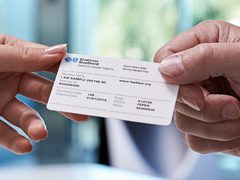Blue HowTo: Health Insurance 101
There are complexities that come with any health insurance policy. But with so many acronyms and a lot of insider lingo, it can be hard to actually understand how it works, and what it means for you as the policyholder. So, let’s start by breaking down some of the key terms and phrases.
What’s Health Insurance?
Health insurance is a contract you make with a health plan, such as Blue Cross and Blue Shield, where that provider agrees to pays for some or all of your healthcare costs in exchange for a premium. Another way to think of it is as a safety net in case you or someone in your family gets hurt or sick. Your health insurance can cover the cost of your medical care, including doctors' visits and prescriptions, as well as dental and vision care, mental health and substance use disorder services.
Your health insurance coverage can be offered through your employer, what’s known as group coverage, or through a health plan that you choose yourself called an individual plan.
Your Premium
Your premium is the amount you’re responsible for paying to your health plan each month. If you get coverage at work, this is automatically taken out of your paycheck, and your employer may even pay some of the cost.
Deductible vs. Copayment
These terms can be confusing as they all circle around payments for your medical services. Your deductible is the specific amount you must reach before your health plan begins to cover your healthcare costs. It is dependent on the plan you choose and can vary dramatically between policies. Once you have payed your deductible, health insurance takes over. Any remaining costs are subject to any copayment or coinsurance fees.
Your copayment (or simply copay) is the fixed amount your health plan requires that you pay for any service, like a checkup or doctor visit. Copays can vary in some situations, like when visiting specialists or paying for prescriptions. Generally, once you pay your copay, there’s no additional amount for you to pay.
Coinsurance
Some health plans have coinsurance. That’s your share of the cost for a service, usually calculated as a percentage. You start paying coinsurance after you pay your deductible. For example, if you have a 20% coinsurance, you pay 20% of each medical bill and your health plan would pay the remaining 80%. Keep in mind that you usually will not have to pay both a copay and coinsurance for the same service.
In-Network vs. Out-of-Network
Your network includes all the doctors, caregivers, hospitals, testing facilities and clinics that are connected to your health plan. They have contracts with your insurer to provide healthcare services at discounted rates. If you visit a hospital or clinic that is in-network, it means that they are part of this contract. Those that are out-of-network will still provide you service, but are not rolled into the lower prices. This may mean you will pay more for medical care.
Preferred Providers
Providers are the actual licensed doctors and caregivers that provide you with healthcare services. Preferred providers are those who are linked to your network. There’s more information about your choice of providers in the Blue Cross and Blue Shield Service Benefit Plan brochures, or you can use our National Doctor and Hospital Finder to find doctors that are included in your plan.
Prior Approval
Before a treatment plan begins, your policy may require a prior approval for the treatment. Sometimes called precertification, prior authorization or preauthorization, this is a decision by your insurer that your medications, care services and overall treatment plan are medically necessary. Depending on your plan, this may be necessary before treatment starts; although emergency medical services are the exception.
Health insurance can be a little confusing at times, but you can count on us to help you stay informed and healthy every step of the way.

